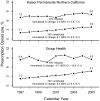Prescription long-term opioid use in HIV-infected patients
- PMID: 21677568
- PMCID: PMC3175344
- DOI: 10.1097/AJP.0b013e3182201a0f
Prescription long-term opioid use in HIV-infected patients
Abstract
Objectives: To examine changes the in use of prescription opioids for the management of chronic noncancer pain in human immunodeficiency virus (HIV)-infected patients and to identify patient characteristics associated with long-term use.
Methods: Long-term prescription opioid use (ie, 120+ days supply or 10+ prescriptions during a year) was assessed between 1997 and 2005 among 6939 HIV-infected Kaiser Permanente members and HIV-uninfected persons in the general health plan memberships.
Results: In 2005, 8% of HIV individuals had prevalent long-term opioid use, more than double the prevalence among HIV-uninfected individuals. However, the large increases in use from 1997 to 2005 in the general population were not observed for HIV-infected individuals. The strongest associations with prevalent use among HIV-infected individuals were female sex with a prevalence ratio (PR) of 1.8 (95% CI=1.3, 2.5); Charlson comorbidity score of 2 or more (compared with a score of 0) with a PR of 1.9 (95% CI=1.4, 2.8); injection drug use history with a PR of 1.8 (95% CI=1.3, 2.6); and substance use disorders with a PR of 1.8 (95% CI=1.3, 2.5). CD4, HIV viral load, and acquired immunodeficiency syndrome diagnoses were associated with prevalent opioid use early in the antiretroviral therapy era (1997), but not in 2005.
Conclusions: Long-term opioid use for chronic pain has remained stable over time for HIV patients, whereas its use increased in the general population. The prevalence of prescribed opioids in HIV patients was highest for certain subgroups, including women, and those with a comorbidity and substance abuse history.
Figures

References
-
- Mack KA, Ory MG. AIDS and older Americans at the end of the Twentieth Century. J Acquir Immune Defic Syndr. 2003;33(Suppl 2):S68–75. - PubMed
-
- Silverberg MJ, Leyden W, Horberg MA, et al. Older age and the response to and tolerability of antiretroviral therapy. Arch Intern Med. 2007;167:684–691. - PubMed
-
- Marcus KS, Kerns RD, Rosenfeld B, et al. HIV/AIDS-related pain as a chronic pain condition: implications of a biopsychosocial model for comprehensive assessment and effective management. Pain Med. 2000;1:260–273. - PubMed
Publication types
MeSH terms
Substances
Grants and funding
LinkOut - more resources
Full Text Sources
Medical
Research Materials

